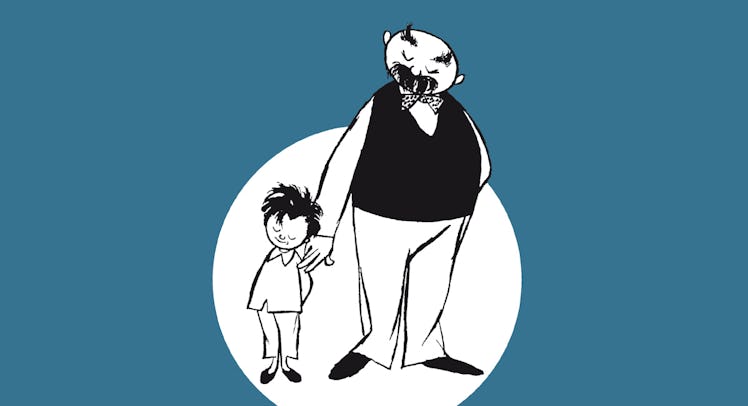Tragic Love and Germany’s ‘Calvin & Hobbes’ for Dads
For a few years before WWII, Father & Son captured the hearts of Germans

Fatherhood is a many hued thing. Some moments are pure joy. Others contain levels of frustration you hadn’t thought possible. Then there’s the self-doubt and the love. It’s a hard thing to capture in words — trust us — and a hard thing to capture in images and a hard thing to capture in both. That’s why comic strips that offer even the slightest nod to the real experience of fatherhood, like Calvin & Hobbes, hit so hard. But no comic strip has captured a father’s rapport with his son as beautifully or accurately as the largely forgotten German comic Father & Son.
Written and illustrated by E.O. Plauen, the comic ran for three years between 1934 and 1937 years in the Berliner Illustrirte Zeitung. In simply drawn forms, Plauen captured the subtleties of parentings. In one typical strip, the unruly boy asks his mustachioed father — theses are the strip’s protagonists — to play with him. The father refuses, saying no with ever increasing volume. The boy cries. The dad relents, hands the kid a toy. The son smiles and leaves. The father regards himself in the mirror then castigates himself. The title is “Scathing self-criticism.” It feels real.
In another, entitled “The lesson of the burned beans,” the dad fucks up a pot of beans. He berates the child for not eating them. The child throws the beans in the trash. The dog refuses the beans. The father, realizing the beans are shit, throws away his beans too. The pair end up happily eating sweets at a pastry shop.
It goes on and on like this, the perfect mixture of flawed anger, intense empathy and overwhelming love. Some of the strips, which were recently reissued in a handsome volume by the New York Review of Books, are genuinely very funny. A lot of them deal with a father realizing how his rage affects his son. A good example: In a three panel cartoon entitled, “The revenge of the stay-at-home,” a father leaves his son in a car, pointing an admonishing finger at him. The boy stands in front of a wall with round stone finials. When the father returns that night, the boy has painted images of an angry father on the stone circles. Hard to explain, I guess, but the meaning is clear. Rage affects those you love. But beyond the rage is a palpable timeless ozone of love and empathy that is as true today as it was eighty years ago.
Had Plauen lived a natural life in a natural time this would be a touching reminder of how our day-to-day feelings remain so assonant with our forbearers. But Plauen didn’t. In fact, his real name wasn’t even E.O. Plauen. It was Erich Ohser. He took the name of his hometown — Plauen — and his initials after he was blacklisted by the Nazis for his caricatures of Hitler. Much of Ohser’s life was spent doggedly trying to survive as an artist and as a human. As Elke Schulze writes in the biographical afterward, Ohser was “tall, heavy set and hard of hearing. Those close to him described him as humorous, awkward, curmudgeonly.” He was just a guy, trying to get by in a world that was quickly changing.
For a time he worked for newspapers under his real name. But his open lampooing of Hitler and the Nationalist Socialists forced him from his job and into his pseudonym. As E.O. Plauen, he wrote Vater und Sohn. It was an immediate hit but, as Nazism rose, the characters’ popularity resulted in their use in Nazi propaganda. Aghast, Plauen quit. Not to sugarcoating it, in 1940 he also worked for Das Reich, Josef Goebbel’s Nazi newspaper. According to Schulze, “Ohser drew political caricatures of the enemies of the Reich, while still trying to differentiate between the Nazi regime and his beloved Germany. Privately steadfast in detesting National Socialism and increasingly disillusioned about the war, Ohser was walking a fraying tightrope.” Frankly, I don’t know what to make of this part. Of those images, there is none of the tenderness or love so apparent in Father and Son. Their misery is made more intense knowing they were made by the same hand.
But what I do know is that in 1944, after Ohser and his friend Erich Knauf were bombed out of their Berlin houses, the men sought refuge in a shelter. There they ill-advisedly gave voice to their resentment against Hitler, which was overheard and reported. Both were arrested that spring for and sentenced to death. Rather than face execution, Ohser hanged himself in his cell at the age of 41. In addition to his wife, he left behind a son, Christian, who was thirteen years old at the time.
This, of course, casts a melancholic pall over the 157 Father and Son strips. These are little artifacts of love in all its complicated, minute, fleeting and deeply affecting splendor. That the same hand that drew with such heart was capable of self-slaughter simply drives home the horrors of war, of which all fathers must be weary, especially those who love their sons as much as Ohser.
This article was originally published on